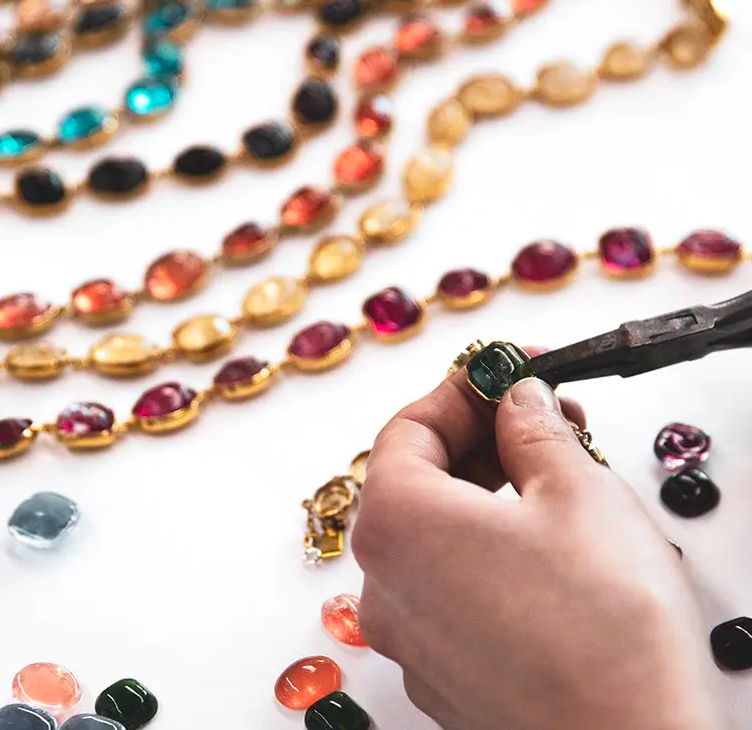Chanel, costume jewelry by Maison Goossens
Precision, workmanship, perfect proportions feature the objects bearing the Goosens hallmark. Born in 1927, during his youth Robert Goosens completed his training in various ateliers in Paris where he learned to work not only with metal but also with other materials such as leather, wood, shell, ivory that he would later use in his own creations.
Robert Goossens
© Goossens
From 1948 he started to work for himself, pursuing his own interest and satisfying his curiosity. Goossens drew his inspiration from the history of Jewelry and especially from various medieval and Byzantine pieces which caught his attention. Their strong cultural aspect and setting of stones and enamels seemed perfect for him to be adapted for haute couture jewelry and offered an interesting alternative to “haute joaillerie”. Even though at first costume jewelries were just an imitation of the real thing for Robert Goosens, overtime he created his own style and chose materials that would enable to exploit fully this kind of jewelry.
Glass Paste setting in Goossens workshop
© Goossens
Goossens preferred to define himself as an artisan rather than an artist as for him the manual dexterity and mastery of the materials came before and allowed the creative imagination.
In 1880, in his “History of Luxury”, Henri Baudrillart dated the origins of “faux jewelry” to the reign of Louis XIV during which the court was emulating the king, but since they were unable to afford pieces made from real stones they resorted to simulated pieces in lieu of flashing jewels. In the 20th century, under the influence of Chanel, costume jewelry was no longer a way to mask or simulate but on the contrary to affirm the true nature of the false, to play deliberately with the ambiguity.
Model wearing Chanel tailor and jewels by Maison Goossens
© Steven Meisel, Vogue 2005
One of Coco Chanel's most important innovations has been to play with the appearances and resorting to humble imitation. She was one of the first fashion designers to make costume jewelry an important element of the silhouette. According to her, jewelry was a way to express yourself but not to showcase wealth. This point of view can be summed up with this sentence she said towards the end of her life “The desire to dazzle sickens me”.
Coco Chanel's strong interest and inspiration from the late Roman Empire and Byzantium stems from her numerous visits to Venice and to the ancient collections in Le Louvre. She thus drew her inspiration from Scythian, Celtic, Syrian or Byzantine pieces which she used either as a guideline to create her own pieces or sometimes copied to perfection.
Robert Goossens for Chanel
Cufff-bracelet in gilded metal decorated with eight ranks of chain and cabochons of glass paste.
© Artcurial
Coco Chanel viewed these jewels as a way to accessorize her models' outfits, sometimes choosing the pieces according to the color of their eyes while the suits and shirts were simply white, therefore giving more importance to the accessories than the apparel pieces.
In 1924 Chanel created its first costume jewelry collection with Maison Gripoix, a company renowned for its glass-enameling and stone cutting techniques. Later, in 1954 Chanel asked Maison Degorce to make some of her first pieces of costume jewelry. Naturally Maison Deforce resorted to the service of Robert Goossens who was also attracted by this “Byzantine baroque” style.
Robert Goossens for Chanel
A green stone & Gilt Metal Cross Pendant, Circa 1950s.
© Christie’s
Even though the Degorce atelier finally closed in 1957, Robert Goossens kept working closely with Coco Chanel until her death in 1971. Both creators learnt from each othe and we can feel a constant dialog going on in these creations, between the fine and the fake, the precious stones and pâtes de verre, the textures and so on.
Robert Goosens continued to work closely with Chanel until her death in 1971, a collaboration that enabled Goosens to explore new ways of expressing his craft, work on challenging projects and overall get better with his own creations.






